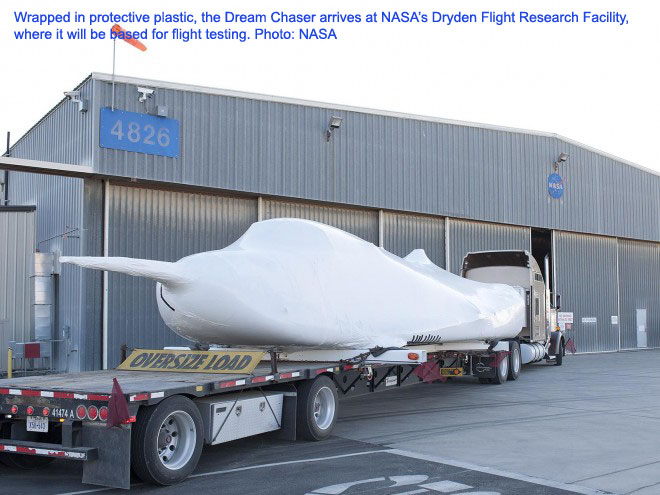.

Sierra Nevada Corporation’s Dream Chaser spacecraft arrived at NASA’s Dryden Flight Research Center, wrapped in plastic and looking a bit like an enormous swordfish, to be prepared for its first test flights.
Dream Chaser is one of three vehicles being developed under NASA’s Commercial Crew Program, which will launch astronauts to the International Space Station and low-earth orbit later this decade. The lifting body vehicle will be reassembled at Dryden over the coming weeks, then begin flight testing next door on the dry lake bed at Edwards Air Force Base in Southern California.
“This will be the first full scale flight test of the Dream Chaser lifting body and will demonstrate the unique capability of our spacecraft to land on a runway,” Sierra Nevada’s Jim Voss said in a statement. “Other flight tests will follow to validate the aerodynamic data used to control the vehicle in the atmosphere when it returns from space.”
The Dream Chaser is the only orbital space vehicle currently in testing that will land like a glider after reentry from space. It is based on lifting body vehicles dating to the 1960s, including NASA’s M2-F2 made famous in the opening sequence of the Six Million Dollar Man. It is a more direct descendent of NASA’s HL-20, a newer lifting body design developed in the 1990s.
.

Since the retirement of the space shuttle, the United States has relied upon Russia’s Soyuz vehicles to get people into orbit. NASA just extended its contract with the Russians, paying an additional $424 million to provide transportation to the International Space Station for six U.S. astronauts through 2017.
Sierra Nevada, Boeing and SpaceX are developing vehicles to fly astronauts to low earth orbit for NASA. Boeing and SpaceX are developing capsule spacecraft that will return to earth under parachute, while the Dream Chaser will return much like the space shuttle orbiters.
After several years of development, wind tunnel testing and refinement, the Dream Chaser team completed its first major safety review with NASA last month. On Sunday, the vehicle was loaded onto a truck at the company’s facility in Colorado and driven west. The team will spend several weeks reassembling the spacecraft and begin a series of ground-based tests, including a tow down the runway to evaluate the landing gear and brakes and a resonance test.
Eventually the Dream Chaser will begin flight tests, starting with a “captive carry” flight suspended beneath a helicopter and autonomous free flights to test the approach and landing system. The flight test vehicle will be dropped from an Erickson Air-crane.While the Dream Chaser is being assembled in the Mojave desert, NASA astronauts in Hampton, Virginia will begin flying simulations of its approach and landing pattern to further evaluate the vehicle’s handling. Using the simulator will allow the team at NASA’s Langley Research Center to “fly” the Dream Chaser in a wide range of atmospheric conditions, as well as several different flight scenarios.
.

5717 Views
